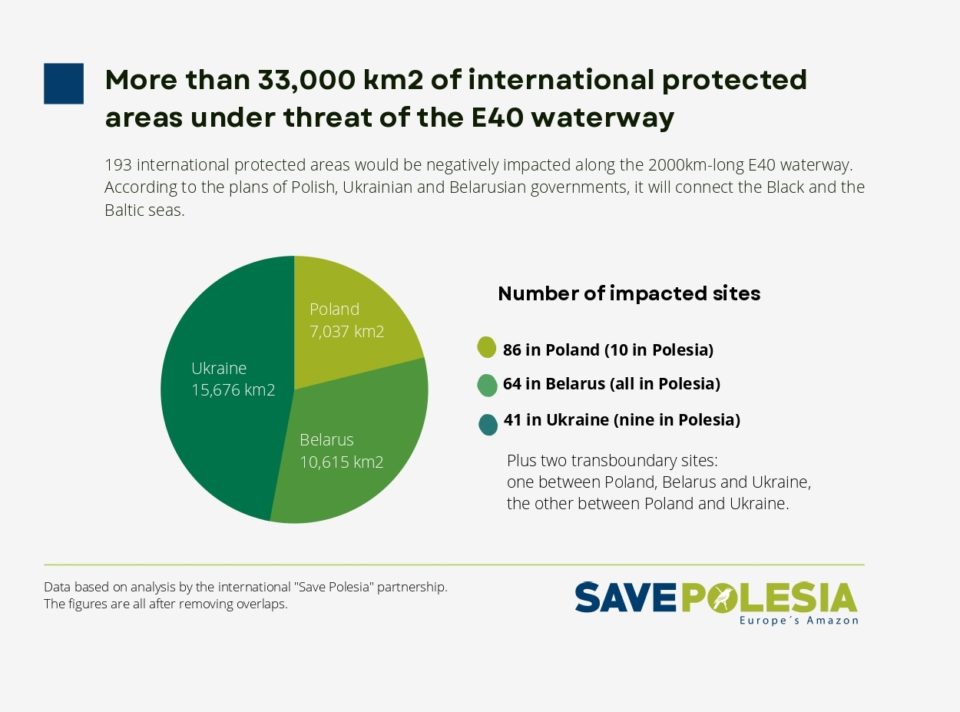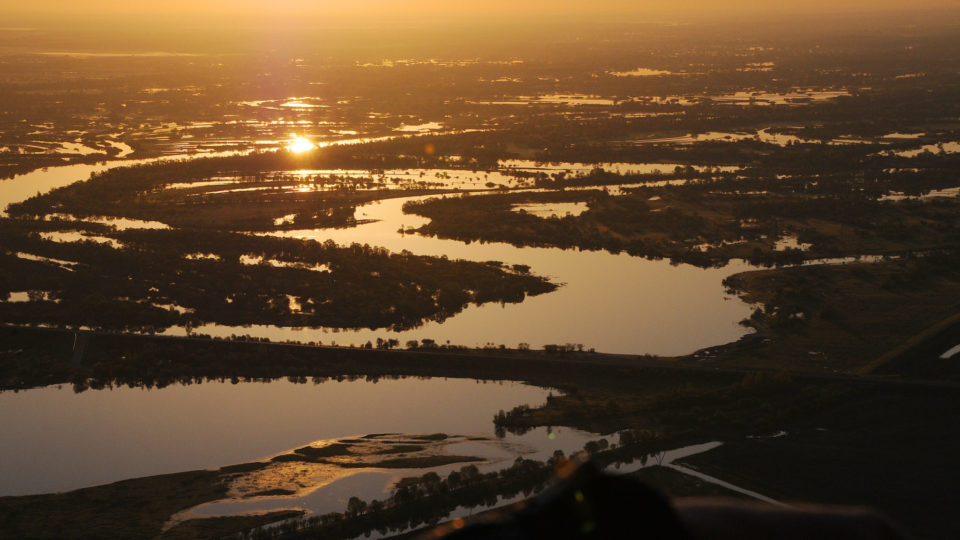A controversial megaproject that aims to connect the Baltic and Black seas via a 2000km-long navigable shipping channel through Poland, Belarus, and Ukraine – known as the E40 inland waterway – would be a catastrophe for biodiversity hotspots and other protected areas, experts have concluded in a major study published to coincide with World Rivers Day.
In a nutshell:
- Extensive analysis of the predicted effects of the E40 waterway on protected areas in Poland, Belarus, and Ukraine indicates adverse impacts on at least 193 international and 139 national protected areas, many severe.
- Experts are calling for abandoning plans to construct the E40 waterway immediately.
- The massive infrastructure project would destroy key biodiversity hotspots and vital hardwood and peatland carbon stores. It would be disastrous for regions such as Polesia, Europe’s largest wetland wilderness area as well as free-flowing sections of Poland’s Vistula river.
- Key breeding sites for many bird species, rare aquatic ecosystems, and habitats home to animals such as Brown Bear, Grey Wolf, Elk, and Eurasian Lynx would come under threat.
- The construction of the E40 waterway would directly contravene international biodiversity commitments.
- The report’s findings are the most comprehensive to date and make it clear that the E40 waterway is a top concern for biodiversity conservation at global level.
In the analysis ‘E40 waterway: impacts on protected areas in Poland, Belarus, and Ukraine’ – published by Frankfurt Zoological Society (FZS) on savepolesia.org – experts underline that plans to construct the shipping channel should be immediately abandoned on biodiversity grounds alone.

The E40 waterway is proposed to run from Gdansk in Poland to Kherson in Ukraine via the Vistula, Pripyat, Dnieper and other rivers. The dredging, damming, straightening, and disruption that would come from the construction and operation of the E40 waterway would have far-reaching direct and indirect impacts on protected areas, habitats, and wildlife in the Vistula river valley in Poland and many other regions. Also Polesia, Europe’s largest wetland wilderness area, would have serious impacts, the analysis reveals.

The new study foresees degraded habitats, blocked migration routes, polluted waters, and species pushed to the brink of extinction unless the governments of Poland, Belarus, and Ukraine abandon plans to develop the shipping channel.
At least 193 internationally protected areas – with a combined size greater than Belgium – would be adversely impacted by the proposed E40 waterway, many severely. About half of these protected lands are in Polesia.
Places affected would include numerous areas of special conservation interest, wetland sites of international importance, and core breeding and resting sites for rare and threatened species. These include 66 Natura 2000 sites in Poland, 52 Emerald sites in Belarus and Ukraine, 16 Ramsar sites, 55 Important Bird and Biodiversity Areas (IBAs), two transboundary UNESCO Man and the Biosphere (MAB) sites, and two Baltic Sea (HELCOM) sites.
If construction of the giant infrastructure project goes ahead, highly threatened habitats such as floodplain hardwood, alluvial forests, transition mires, and quaking bogs would be degraded or destroyed.
Wildlife affected would include rare birds such as the Aquatic Warbler and Greater Spotted Eagle; mammals such as the Giant Noctule Bat, Brown Bear, Grey Wolf, Elk, and Eurasian Lynx; aquatic species such as the Atlantic Salmon, European Eel and European Pond Turtle; and endangered flora such as the carnivorous Waterwheel Plant.
In Poland, the planned E40 waterway would not just cross protected Natura 2000 sites, but go along whole sites. It would devastate eight Natura 2000 sites on the Vistula River, plus one on Wieprz River. Polish breeding populations of Little Tern, Eurasian Oystercatcher, Common Ringed Plover and Mew Gull would decrease by half.
The authors of the new report warn that the E40 waterway’s construction would be in direct conflict with international biodiversity commitments such as under the Convention for Biological Diversity, the Ramsar and Bern conventions, and the EU’s Biodiversity Strategy.
It is the latest in a series of expert reports that have shown government-commissioned assessments used to justify the E40 waterway appear to be deeply flawed. The analyses show that the proposed shipping channel would come at a huge cost to both the environment and economy in Poland, Belarus, and Ukraine. Moreover, it constitutes one of the top emerging issues of concern for biodiversity conservation at a global level.
With climate change exacerbating the effects of environmental degradation, the authors have also called for further studies into the negative hydrological impacts of the E40 waterway in order to understand its full potential impacts on the natural world.
Views from experts
The report is authored by nature conservation experts from the Save Polesia partnership of leading nature conservation organisations led by Helen Byron and Wouter Langhout, independent consultants working with Frankfurt Zoological Society (FZS). Together the experts who have contributed to the report have spent decades working for nature conservation.
“Hundreds of international and national protected areas are on red alert,” said Helen Byron, Save Polesia Campaign Coordinator. “This hugely important report makes clear that plans to construct the waterway must be abandoned to avoid environmental, social, and economic catastrophe in Polesia and beyond. Focus must instead turn to sustainable approaches such as ecotourism, and ensuring that Polesia gains additional international protection and recognition to ensure that its vital landscapes and habitats remain intact.”
“This report summarises the monumental scale of the threats posed to legally protected areas by the planned construction of the E40 waterway in all three countries that it would pass through,” said Małgorzata Górska, Save Polesia Campaign Coordinator at the Polish Society for the Protection of Birds (OTOP). “In times of climate change and biodiversity crises the construction of the E40 waterway is unacceptable. Instead of damming rivers with hydrotechnical developments, we need to protect and re-naturalise them.”
“The threat of the E40 waterway continues to loom large over Polesia,” said Heorhiy Veremiychyk, Save Polesia Campaign Coordinator at the National Ecological Center of Ukraine (NECU). “The report lays bare the irreversible losses that the shipping channel would lead to. All the evidence points to the conclusion that the project must be abandoned so that Polesia is preserved in its natural state for future generations. National governments must make a final decision to finally abandon plans to build the E40 waterway.”
Media contact
Frankfurt Zoological Society, Save Polesia Campaign Coordinator
Dr Helen Byron phone: +44 (0) 7713 255675, E-mail: [email protected]
Additional information
- Save Polesia is now an international partnership of four civil society organisations – Bahna (Belarus), the Frankfurt Zoological Society, the National Ecological Centre of Ukraine, and the Polish Society for the Protection of Birds. While working on the analysis the coalition also included APB-Birdlife Belarus, which was operating until mid-March 2022. We strive to protect Polesia for the citizens of Belarus, Poland, Ukraine and wider Europe – now and in the future. We stand against the construction of the E40 waterway and for the development of nature-based tourism in Polesia.
- Download the ‘Save Polesia’ factsheet on the protected areas study (PDF in EN, PL and UKR)
- Download the expert protected areas study ‘E40 waterway: impacts on protected areas in Poland, Belarus and Ukraine’
- Eight infographics on the expert protected areas study (PDF in EN)
- Five key maps on the expert protected areas study (PDF in EN and PL)
- Three wildlife photos and four aerial views of Polesia are available here. Copyright: © Daniel Rosengren / FZS
- Video about Polesia is available here.
- More information on Polesia, the waterway, the solution and the international coalition ‘Save Polesia’ on savepolesia.org

